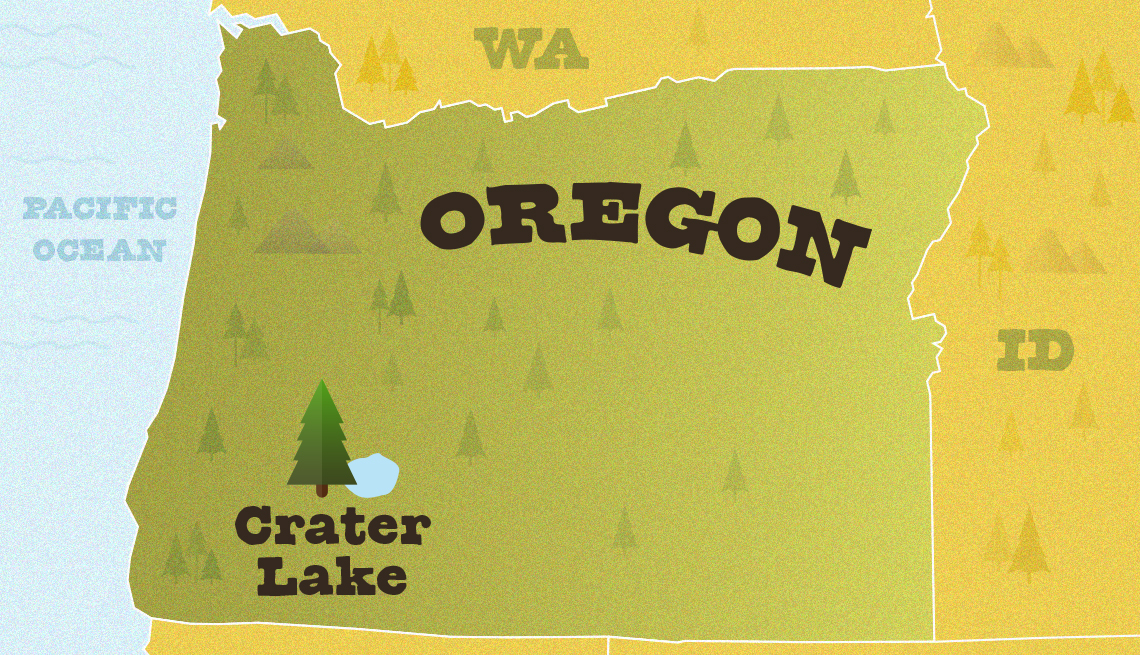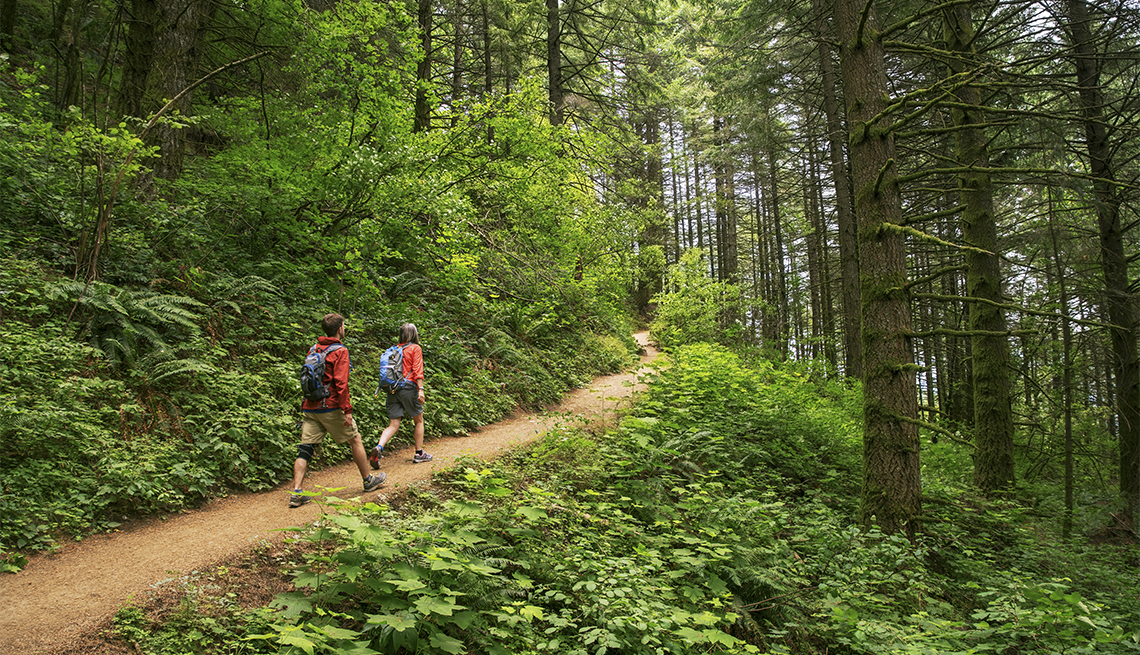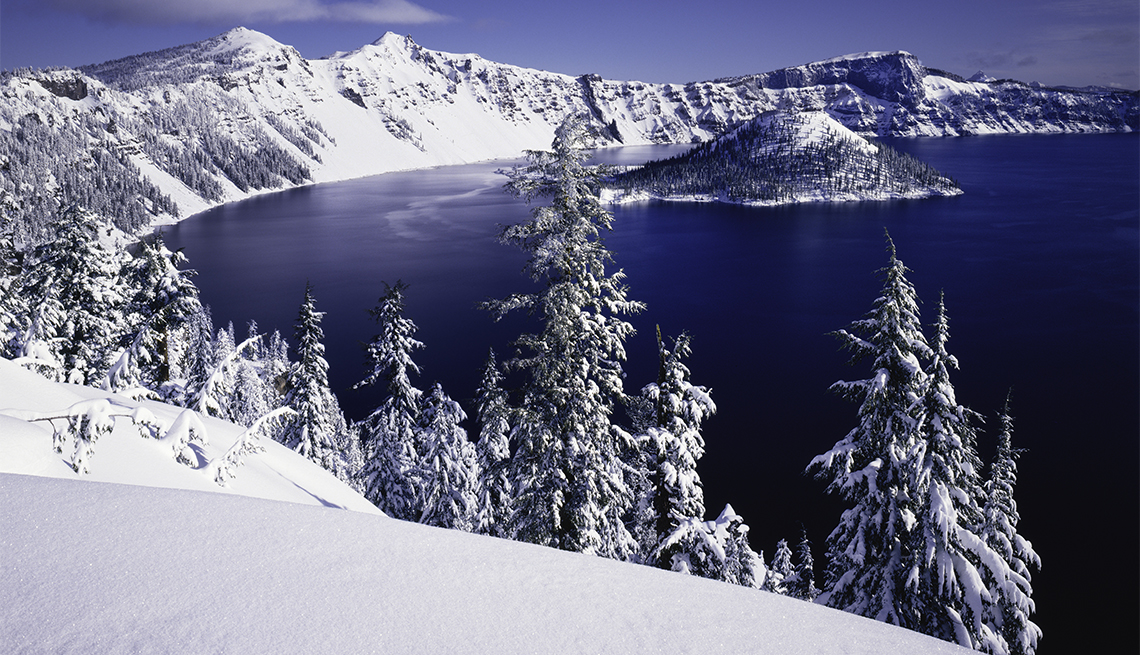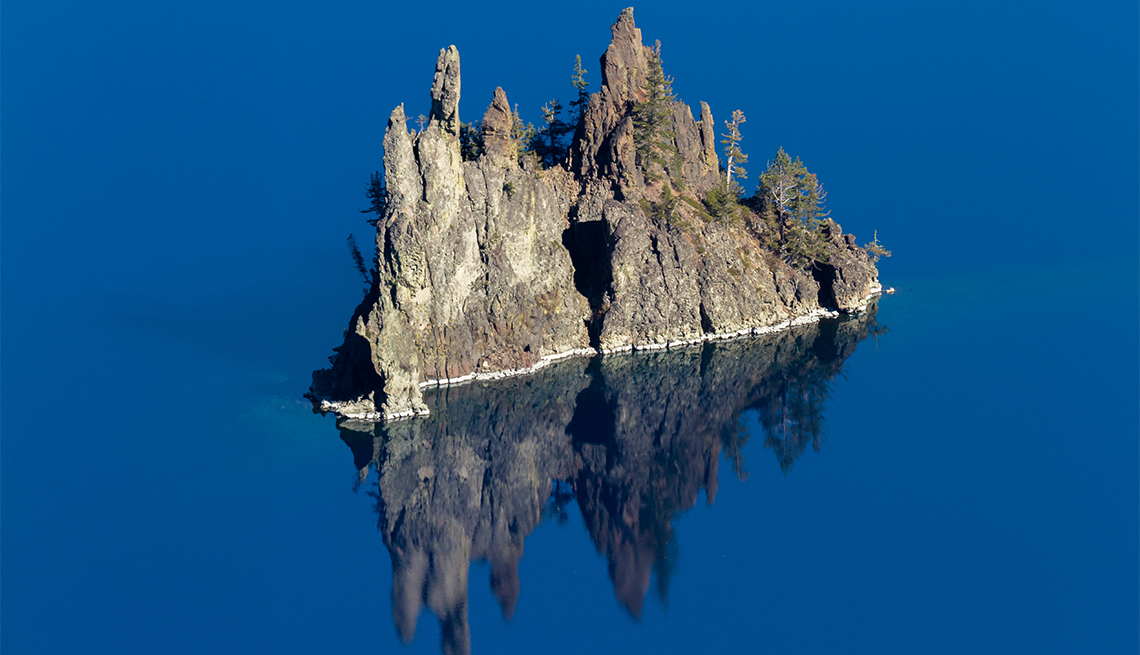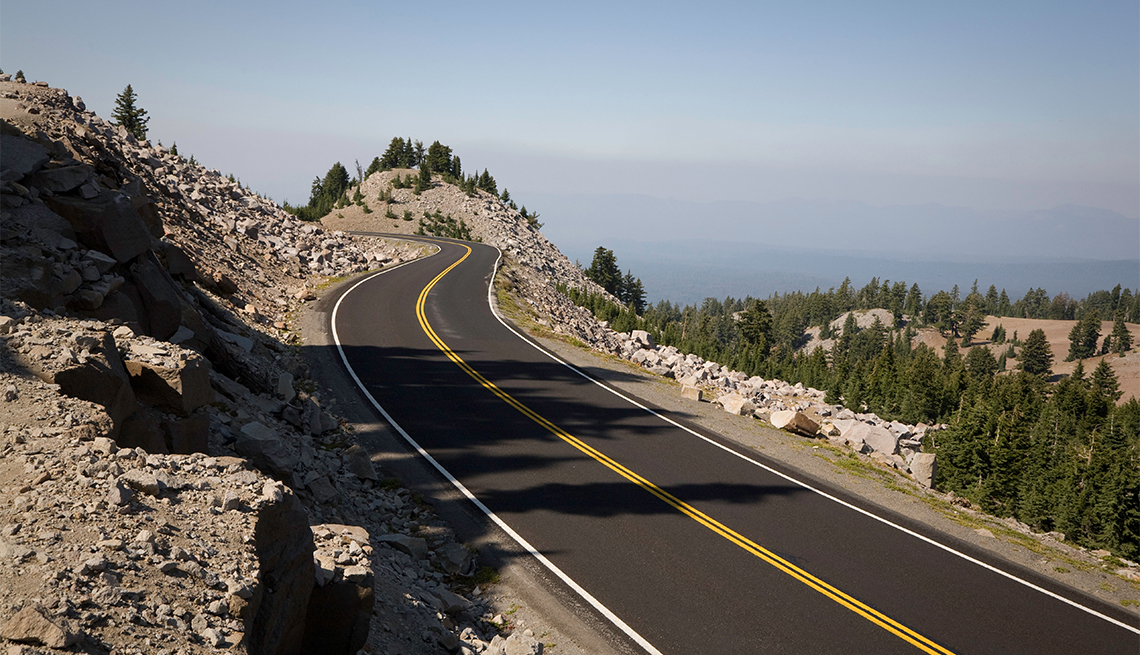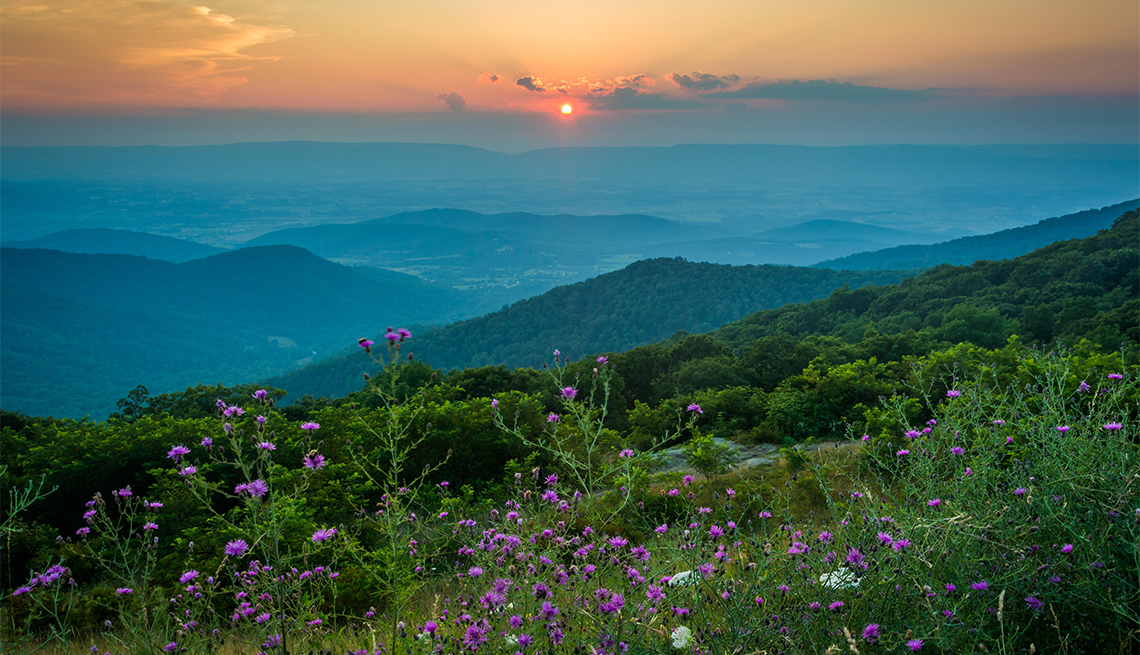Guide to Crater Lake National Park
Enjoy gorgeous hikes, drives, water views and adventure in Oregon
At first view, Crater Lake's sheer beauty may just take your breath away. Formed 7,700 years ago by the collapse of volcanic Mount Mazama, the lake lies sheltered inside the 2,000-foot cliffs of the dormant volcano's caldera, a serene cobalt blue reminder of Earth's fiery history.
At 1,943 feet deep, Crater Lake ranks as the country's deepest lake, and the world's ninth-deepest. Filled almost entirely by rain and snowfall, it's one of the world's clearest lakes — scientists have measured the water's clarity to as deep as 143 feet. Its vibrant color inspired Native American legends claiming that the mountain bluebird, originally gray, turned blue after dipping into its waters.
The spectacular views of this 21-square-mile lake lure visitors to Crater Lake National Park (CLNP) in southern Oregon, as do its natural formations of Wizard Island and Phantom Ship. The former, a cinder cone named for its wizard-hat shape, was created when Crater Lake first filled with water after the volcano collapsed. Phantom Ship, a small island with tall rock formations resembling a sailing ship, can seem to appear and disappear, depending on lighting and weather conditions.
In all, CLNP spans 183,224 acres, with mountain peaks and evergreen forest covering the once-barren landscape around the lake. Few realize that under this beautiful veneer lies an outstanding outdoor laboratory and classroom. Park studies have provided critical information on the ecology of the Sierra Nevada red fox, one of North America's rarest mammals, and deepwater research has discovered a hidden garden of ancient moss far beneath the surface.
Seventeen years of lobbying by journalist William Gladstone Steel led to the park's establishment in 1902. Oregon's only national park, CLNP attracts more than 700,000 visitors annually, including couples, families, adventure-seekers and those in search of outdoor rejuvenation. “With Rim Drive encircling the primary feature of the park, it's easy to get lots of great views of the lake and surrounding geologic features without much effort, making it popular with all age groups,” says Marsha McCabe, the park's chief of interpretation and education.
Plan Your Trip
CLNP is easily accessed from Portland, 231 miles north of the park. Take Interstate 5 down to Eugene, then connect to Highways 58, 97 and 138 to the park's North Entrance (it also has south and west entrances). It's easy to drive in the park, especially on Rim Drive, where many overlooks serve up beautiful lake views.
Location: Southern Oregon
Acreage: 183,224
Highest peak: Mount Scott, at 8,929 feet
Lake depth: 1,943 feet
Miles and number of trails: More than 90 miles along 16 front-country trails
Main attraction: Crater Lake
Entry fee: $30 per vehicle (annual Senior Pass $20)
Best way to see it: Driving the 33-mile Rim Drive around the edge of the crater
When to go to avoid the crowds: September through May
The most popular months at CLNP are July, August and September, when the park's roads, trails and facilities are usually fully open. In the transitional months of May and June, winter slowly loosens its grip and gives way to summer, although lingering snow can sometimes prevent visitors from accessing much of the park. It's still worth visiting at this less-crowded time, as long as you come with realistic expectations of what you'll be able to see and do. The same goes for autumn visits: Rim Drive closes to cars when the deep snow arrives, sometimes as early as mid-October, but always by Nov. 1, when the park becomes a haven for skiing and snowshoeing. Given that unpredictable weather plays a factor in access, always check alerts and conditions.
"Crater Lake National Park seems like two different parks, from summer to winter,” McCabe says. “Even though the blanket of winter snow brings a stark beauty, the park's just as spectacular cloaked in the blue and emerald of summer."
Most of CLNP's territory lies in the backcountry, generally inaccessible to visitors with mobility impairments, but several front-country trails are fully accessible, and others have portions that may be possible with assistance. Some hiking trails have benches for rest stops, especially the accessible ones such as Godfrey Glen. The pedestrian-only promenade at the caldera's southwestern edge in Rim Village, where most visitor services are concentrated, is an easy half-mile walk from one end of the village to the other with good views of the lake along the way.
Restrooms are widely available throughout the park, but not cell reception, which is spotty, depending on your location and provider. The lodge is one of the only relatively reliable areas for cell coverage.
Where to Stay and Eat
Crater Lake Lodge, the park's iconic hotel built in 1915, overlooks the lake at Rim Village. Although renovated in the early 1990s, the 71-room lodge still retains the rustic atmosphere of its early days, especially in the Great Hall and dining room, with their wood-beamed ceilings, stone walls and grand stone fireplaces creating a warm, cozy ambience. The dining room's fine-dining menu highlights seasonal, sustainable ingredients grown, raised or caught in Oregon — from smoked salmon to wild mushrooms. Although it's only open for breakfast and dinner, you can preorder box lunches for picnics. Standard-looking guest rooms come with modern amenities, except they have no phones or televisions. Booking tip: For the best crater views, try to snag a fourth-floor room.
CLNP's other village, the Cabins at Mazama Village, lies near Oregon Route 62, tucked into a Ponderosa pine grove. Each of the 40 rustic cabins has one or two queen beds and a private bathroom, but no TV or phone.
Sleep under the stars at Mazama Campground, with 214 sites for tents and RVs, each with a picnic table, fire ring and bear-resistant food locker, and some with full hookups. Other amenities include restrooms and water spigots. All sites ($21 to $43 per night) at the summer-only campground are first-come-first-served in June; in July, August and September, 75 percent can be reserved in advance either online or by calling 866-292-6720.
You'll find a smaller, primitive tents-only campground, Lost Creek, on the road to the Pinnacles Overlook, three miles southeast of the lake's rim. Its 16 first-come-first-served sites ($5 per night) also have picnic tables and food lockers. There are portable toilets but no water is provided, so be sure to bring your own. Registration is self-service.
In-park dining is limited. In Mazama Village, Annie Creek Restaurant and Gift Shop will fill you up with hearty meals at breakfast, lunch and dinner (try the maple Dijon pork loin chops), and offers a nice selection of made-in-Oregon beer and wine.
At the Rim Village Café, next to Crater Lake Lodge, choose from salads, sandwiches and snacks. Take in the scene from its patio while you eat, or take a grab-and-go meal to nearby Picnic Hill, a beautiful wooded area with glimpses of Crater Lake from some spots. Farther away, on East Rim Drive, Whitebark Pine Picnic Area, in a pine grove, has delicious views of Mount Scott, the park's highest peak.
Things to Do
Sightsee by car. Crater Lake itself is the park's main attraction, and one of the easiest ways to take in its beauty is driving the 33-mile loop around the lake on Rim Drive, with 30 overlooks to relish the views. “The Pumice Castle Overlook offers the best view of this interesting geologic formation made of orange-colored welded tuff that resembles a castle,” McCabe says. “Another spot not to miss is the Phantom Ship Overlook, which offers the best view of Phantom Ship from Rim Drive."
Don't want to drive? Catch a trolley tour ($29; $26, seniors) from Rim Village for a two-hour ride with five Rim Drive stops, complete with a park ranger narrating stories about CLNP's history and landscape. Or cycle the route, if you're up for the challenge, but be prepared to share the road with motorists because it has no shoulders or bike lanes.
Get out on the water. The park's concessionaire, Crater Lake Hospitality, offers two powerboat tours. On its standard two-hour lake cruise, get up-close views of Wizard Island, Phantom Ship and other natural formations. The Wizard Island tour cruises around the lake's perimeter and stops at the isle so guests can hike, swim or just drink in the views. Note: These tours aren't for everyone. Accessing the boat dock requires hiking the Cleetwood Cove Trail (2.2 miles round trip), a steep trail with a 700-foot elevation change that can be strenuous.
Get active. Sixteen front-country hiking trails covering more than 90 miles range from easy to difficult. For easy hikes doable by almost anyone, including all-terrain wheelchair users (with assistance), McCabe recommends the Godfrey Glen, Plaikni Falls and Sun Notch trails. “They're short and the elevation gain isn't particularly challenging,” she says.
Stroll along a 1.1.-mile loop through an old-growth forest on the Godfrey Glen Trail. You'll find the trailhead a little more than two miles south of Park Headquarters on Volcanic Legacy Scenic Byway. Access the Plaikni Falls Trail off Pinnacles Road, just over a mile southeast of the Phantom Ship Overlook. On this 2-mile round-trip trek, you'll pass through another old-growth forest en route to a lush waterfall. (Note: The final quarter of this hike might be too steep for wheelchair users.) On the Sun Notch Trail, a 0.8-mile loop, make a short uphill walk through a wildflower-strewn meadow to Crater Lake's rim for magnificent views of Phantom Ship. Look for the trailhead off East Rim Drive a little more than 4 miles east of Park Headquarters.
Go off the beaten path. Drive to the end of Pinnacles Road, six miles southeast of the Phantom Ship Overlook, to the Pinnacles, 100-foot-tall spires created as the canyon walls eroded over the years. The spires mark places where volcanic gas rose up through hot ash deposits, cementing the ash into solid rock. Spy the formations from above at the overlook, or take the easy 0.8-mile Pinnacles Trail to see them from different angles.
Interact with park rangers. In summer, rangers lead hikes to various locations, such as the moderate sunset hike from Watchman Overlook to a fire lookout. From that vantage point, it's quite the sight to see the sun set behind the Cascade mountain range. The 1.8-mile, round-trip hike, offered daily, starts from the overlook, 3.8 miles northwest of Rim Village along West Rim Drive.
Also in summer, learn about the park and its environment with daily ranger-led informative talks at Crater Lake Lodge, the Mazama Campground amphitheater and the Sinnott Memorial Overlook in Rim Village. Topics vary at the hour-long presentations, including the geology of Mount Mazama, formation of Crater Lake, lake ecology and park history.
Do some casting. Fish for kokanee salmon and rainbow trout in the lake, and for brook and brown trout in the park's streams (except for Lost Creek and Sun Creek, where the park is engaged in a long-term project to restore a sustainable population of bull trout, the only fish native to CLNP). Bring your own gear, but you don't need a fishing license inside the park. To prevent the introduction of non-native organisms into the lake and streams, you can only use nonorganic, artificial lures.
Enjoy winter activities. In cold-weather months, ranger-guided snowshoe walks wander through the subalpine forests and meadows along the lake rim, giving you an up-close look at the winter landscape. Snowshoes are provided on the 1- to 2-mile excursions, and advance reservations at the Steel Visitor Center at Park Headquarters are recommended. Bring your own gear to go skiing (cross-country or downhill), sledding or snowboarding.
Gateway Towns
No major towns are near CLNP entrances, but Klamath Falls, Medford and Ashland are within driving distance. Each has its own drawing card, so if you want to base yourself outside the park, pick the one that best fits your interests.
Birders flock to Klamath Falls, a Pacific Flyway destination 43 miles south of the park that hosts the country's oldest bird festival every February. The Klamath Basin's diverse landscape, which includes juniper woodlands, marshes and sagebrush grasslands, attracts more than 250 bird species. At the Klamath Basin Refuge, you'll find the largest wintering concentration of bald eagles — up to 1,000 of them — in the lower 48 states.
The town appeals to outdoor enthusiasts, as well, for its easy access to scenic hiking, wild-water rafting and golf.
Embrace the natural wonders at Running Y Ranch Resort, an all-season property with a lodge, chalets and custom homes. If you're budget-minded, book the downtown Cerulean Hotel. Order a pint of beer and chow down on a burger or tomahawk pork chops at Klamath Basin Brewing Co., the first geothermal brewing company in the U.S.
The emerging culinary hot spot of Medford, 65 miles southwest of the park and a gateway to the Rogue Valley, will surprise you with its amazingly good restaurants. Two to try: At Bambu, the menu blends regional Asian cuisines with dishes such as Thai coconut soup and chargrilled Korean barbecue beef. Larks Kitchen & Cocktails, at the Inn at the Commons, serves classics with a twist, such as Southern fried chicken with house-smoked bacon gravy and sour cream-onion mashed potatoes.
Medford is also gaining credibility as a wine destination, a place where young winemakers with relatively little capital come to try making their mark on the American wine scene. Drop in at Dancin Vineyards in the forested foothills overlooking the Rogue Valley to taste Burgundian-style pinot noirs and chardonnays, or grab a seat in the tasting room at 2Hawk Vineyard & Winery to sample its red and white wines.
Stay at the Inn at the Commons, a reimagined 1960s motor inn, or the Rogue Regency Inn, just minutes from the Medford Airport.
Culture grabs the spotlight in Ashland, 13 miles south of Medford. The city hosts the Oregon Shakespeare Festival every year from late February through October, and it has many art galleries featuring everything from photography and watercolors to glass art and sculpture. Two to check out: Art & Soul Gallery and the Hanson Howard Gallery.
In winter, hit the slopes at the Mount Ashland Ski Area, with its corniced and steep glacier bowl.
Splurge on lodging at the 70-room Ashland Springs Hotel, restored to its 1925 glittering splendor with Gothic and beaux-arts architecture, or the six-room Peerless Hotel for Victorian elegance. Sweet budget spots to lay your head include the Best Western Windsor Inn and the Plaza Inn & Suites at Ashland Creek. Satisfy your hunger with modern American cuisine at Hearsay Restaurant, Lounge & Garden, or with fresh local bistro fare at Alchemy Restaurant and Bar.
AARP Membership -Join AARP for just $12 for your first year when you enroll in automatic renewal
Join today and save 25% off the standard annual rate. Get instant access to discounts, programs, services, and the information you need to benefit every area of your life.
En Route
Southern Oregon is home to several nationally designated, free-flowing Wild and Scenic rivers, including the Rogue, just west of the park. For fun on the water, go kayaking or rafting on any of these rivers, or take an exciting jet-boat ride.
It's also a rich wine region, with 150 wineries in Applegate Valley, Illinois Valley, Rogue Valley and Umpqua Valley — each with a distinct personality and terroir. Due to Applegate Valley's wide range of microclimates and soil variances, winemakers there grow a variety of grapes and produce an array of wine types. In Grants Pass, sample the valley's diverse pours at Troon Vineyard, which focuses on naturally produced wines using native yeast fermentations; and Wooldridge Creek Winery, with 56 acres planted in 12 varietals.
Explore wilderness on the 171-mile Oregon Outback Scenic Byway across the Great Basin to the east of the park. It's a life-size geologic textbook with a geyser, natural hot springs and petroglyphs. Among the don't-miss sights: the gentle sage slopes of Hart Mountain National Antelope Refuge with remnant herds of pronghorn antelope. Nearby, relax with a soak at Antelope Hot Springs.
- |
- Photos
Editor's note: This article was originally published on October 16, 2020. It's been updated to reflect recent COVID-19 developments.


